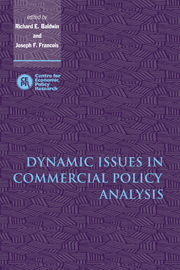Book contents
- Frontmatter
- Contents
- List of figures
- List of tables
- Preface
- List of conference participants
- 1 Introduction
- 2 Transition dynamics and trade policy reform in developing countries
- 3 Putting growth effects in computable equilibrium trade models
- 4 Innovation, capital accumulation, and economic transition
- 5 Multinational production, skilled labour, and real wages
- 6 Economic policy and the manufacturing base: hysteresis in location
- 7 Trade liberalization and investment in a multilateral framework
- 8 Investment creation and investment diversion: simulation analysis of the Single Market programme
- 9 Blueprints, spillovers, and the dynamic gains from trade liberalization in a small open economy
- 10 Trade policy and North–South migration
- 11 Long-term modelling of trade and environmental linkages
- 12 Labour markets and dynamic comparative advantage
- Index
8 - Investment creation and investment diversion: simulation analysis of the Single Market programme
Published online by Cambridge University Press: 13 January 2010
- Frontmatter
- Contents
- List of figures
- List of tables
- Preface
- List of conference participants
- 1 Introduction
- 2 Transition dynamics and trade policy reform in developing countries
- 3 Putting growth effects in computable equilibrium trade models
- 4 Innovation, capital accumulation, and economic transition
- 5 Multinational production, skilled labour, and real wages
- 6 Economic policy and the manufacturing base: hysteresis in location
- 7 Trade liberalization and investment in a multilateral framework
- 8 Investment creation and investment diversion: simulation analysis of the Single Market programme
- 9 Blueprints, spillovers, and the dynamic gains from trade liberalization in a small open economy
- 10 Trade policy and North–South migration
- 11 Long-term modelling of trade and environmental linkages
- 12 Labour markets and dynamic comparative advantage
- Index
Summary
Introduction
The European Union's Single Market programme altered commercial realities in Europe, making it easier for firms based in one European Union (EU) market to compete in other EU markets. This had a generally positive effect on EU economies yet, because the programme initially applied only to EU nations, it unintentionally threatened firms based in non-EU nations. The threat is easy to understand. By lowering the cost of doing business on an intra-EU basis, without lowering costs for non-EU firms, the programme altered the relative competitiveness of EU and non- EU firms in EU markets. This loss of competitiveness constituted a severe problem for the nations of the European Free Trade Association (EFTA) because 60 per cent of EFTA exports go to EU markets.
Many EFTA firms decided to adjust by becoming EU-based firms. The result was a well-documented outflow of direct investment from EFTA nations to EU nations. Moreover, after 1989, total investment in the EFTA countries slumped faster and farther than it did in EU nations, and the Single Market programme may have had something to do with this. EFTAns also experienced a deeper and longer recession than the EU nations. In stark contrast, the two European economies that were rapidly integrating with the EU during the mid- to late 1980s – Spain and Portugal – experienced exactly the opposite pattern. Net foreign direct investment flowed in at an increasing pace, and they experienced investment- led surges in their GDP growth.
Of course, many factors were responsible for these trends. One factor that is often mentioned, however, is the impact of the Single Market programme.
- Type
- Chapter
- Information
- Dynamic Issues in Commercial Policy Analysis , pp. 228 - 268Publisher: Cambridge University PressPrint publication year: 1999
- 3
- Cited by



